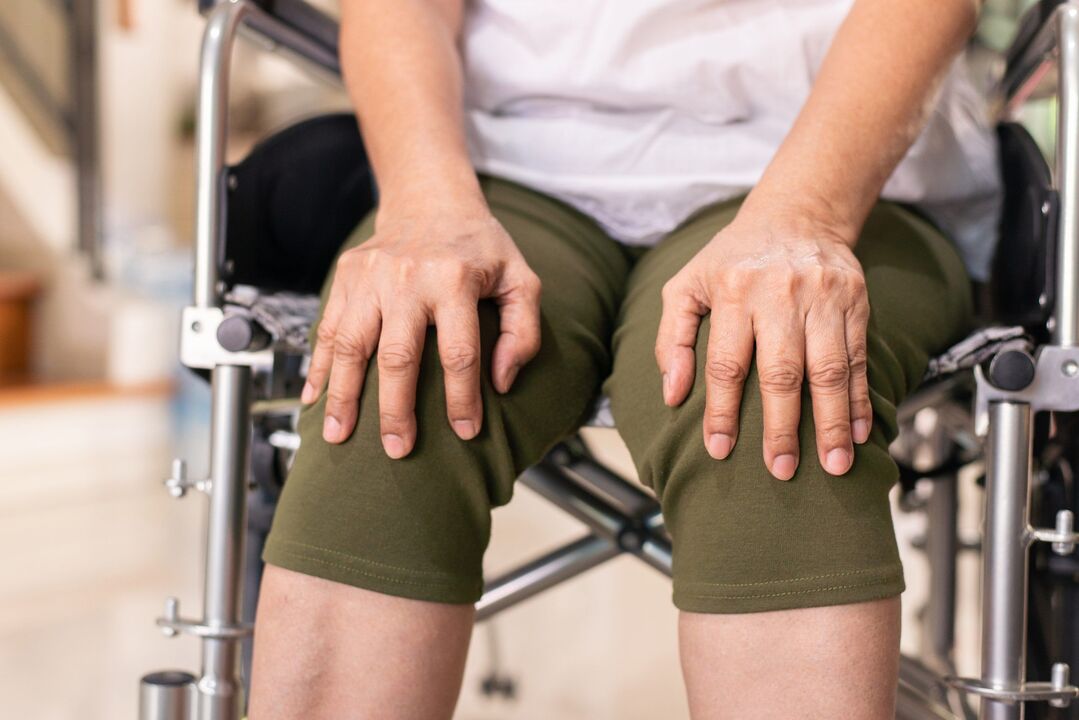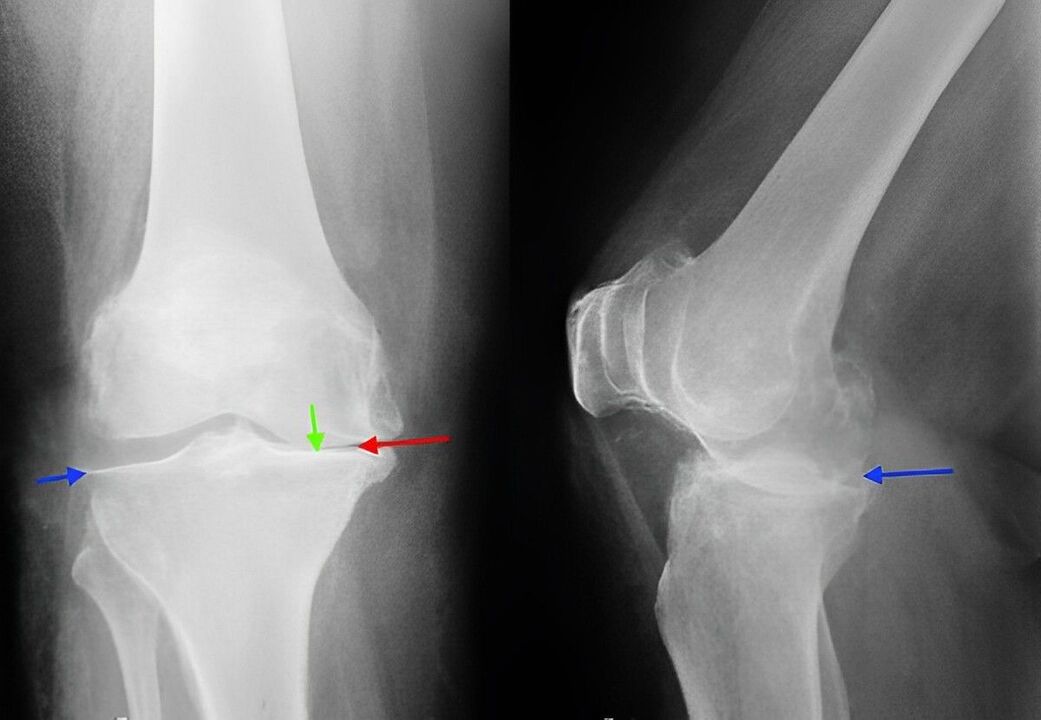
Gonarthrosisis deforming osteoarthritis of the knee joint. It is accompanied by damage to the hyaline cartilage of the articular surfaces of the tibia and femur and has a chronic progressive course. Clinical symptoms include pain that worsens with movement, limitation of movement, and synovitis (fluid buildup) in the joint. In the later stages, the support of the leg is impaired and there is a pronounced limitation of movements. Pathology is diagnosed based on anamnesis, complaints, physical examination and x-ray of the joint. Treatment is conservative: drug therapy, physiotherapy, exercise therapy. If there is significant destruction of the joint, endoprosthesis is indicated.
General information
Gonarthrosis (from the Latin genus articulatio - knee joint) or deforming arthrosis of the knee joint is a progressive degenerative dystrophic lesion of the intra-articular cartilage of a non-inflammatory nature. Gonarthrosis is the most common osteoarthritis. It usually affects middle-aged and elderly people, with women being most affected. After injury or constant, intense stress (for example, during professional sports), gonarthrosis can occur at a younger age. Prevention plays the most important role in preventing the occurrence and development of gonarthrosis.
Contrary to popular belief, the cause of the development of the disease is not the deposition of salts, but rather malnutrition and changes in the structure of intra-articular cartilage. In gonarthrosis, foci of calcium salt deposition may occur at the site of insertion of the tendon and ligament apparatus, but they are secondary and do not cause painful symptoms.
Causes of gonarthrosis
In most cases, it is impossible to identify any reason for the development of pathology. As a rule, the occurrence of gonarthrosis is caused by a combination of several factors, including:
- Injuries. Approximately 20-30% of cases of gonartosis are associated with previous injuries: tibial fractures (especially intra-articular), meniscal injuries, ligament ruptures or ruptures. Typically, gonarthrosis occurs 3-5 years after a traumatic injury, although an earlier development of the disease is possible - 2-3 months after the injury.
- Physical exercise. The manifestation of gonarthrosis is often associated with excessive loads on the joint. The age of 40 and over is a period in which many people understand that regular physical activity is necessary to keep the body in good condition. When starting exercises, they do not take into account age-related changes and unnecessarily load the joints, which leads to the rapid development of degenerative changes and the appearance of symptoms of gonarthrosis. Running and fast, intense squats are especially dangerous for knee joints.
- Overweight. With excess body weight, the load on the joints increases, both microtraumas and serious injuries (meniscus tears or ligament ruptures) occur more often. Gonarthrosis is especially difficult in obese patients with severe varicose veins.
The risk of gonarthrosis also increases after previous arthritis (psoriatic arthritis, reactive arthritis, rheumatoid arthritis, gouty arthritis, or ankylosing spondylitis). In addition, risk factors for the development of gonarthrosis include genetically determined weakness of the ligamentous apparatus, metabolic disorders and impaired innervation in certain neurological diseases, traumatic brain injuries and spinal cord injuries.
Pathogenesis
The knee joint is formed by the articular surfaces of two bones: the femur and the tibia. On the front surface of the joint is the patella, which, when moving, slides along the depression between the condyles of the femur. The fibula does not participate in the formation of the knee joint. Its upper part is located on the side and just below the knee joint and is connected to the tibia through a low-motion joint.
The articular surfaces of the tibia and femur, as well as the posterior surface of the patella, are covered with smooth, very strong and elastic, densely elastic hyaline cartilage 5-6 mm thick. Cartilage reduces friction forces during movements and performs a shock-absorbing function during shock loads.
In the first stage of gonarthrosis, blood circulation in the small intraosseous vessels that feed the hyaline cartilage is disturbed. The surface of the cartilage becomes dry and gradually loses its smoothness. Cracks appear on its surface. Instead of gliding smoothly and unhindered, the cartilages "stick" to each other. Due to constant microtraumas, the cartilaginous tissue becomes thinner and loses its shock-absorbing properties.
In the second stage of gonarthrosis, compensatory changes occur in bone structures. The joint platform is flat, adapting to increased loads. The subchondral zone (the part of the bone located immediately below the cartilage) becomes thicker. Bone growths appear along the edges of the articular surfaces - osteophytes, which in their appearance on an x-ray resemble thorns.
During gonarthrosis, the synovial membrane and joint capsule also degenerate and become "wrinkled. "The nature of the articular fluid changes - it thickens, its viscosity increases, which leads to a deterioration in its lubricating and nutritional properties. Due to lack of nutrients, cartilage degeneration accelerates. The cartilage becomes even thinner and in some areas disappears completely. After the cartilage disappears, friction between the articular surfaces increases markedly and degenerative changes progress rapidly.
In the third stage of gonarthrosis, the bones become significantly deformed and appear pressed against each other, significantly limiting movement of the joint. Cartilaginous tissue is practically absent.
Classification
Taking into account the pathogenesis in traumatology and orthopedics, two types of gonarthrosis are distinguished: primary (idiopathic) and secondary gonarthrosis. Primary gonarthrosis occurs without prior trauma in elderly patients and is usually bilateral. Secondary gonarthrosis develops against the background of pathological changes (diseases, developmental disorders) or injuries in the knee joint. It can occur at any age, usually unilateral.
Taking into account the severity of pathological changes, three stages of gonarthrosis are distinguished:
- First step– initial manifestations of gonarthrosis. Characterized by periodic dull pain, usually after significant load on the joint. There may be slight swelling of the joint that goes away on its own. There is no deformation.
- Second stage– increased symptoms of gonarthrosis. The pain becomes longer and more intense. A grinding sound often appears. There is a mild or moderate restriction of movement and slight deformation of the joint.
- Third stage– the clinical manifestations of gonarthrosis reach their maximum. The pain is almost constant and walking is impaired. There is a pronounced limitation of mobility and noticeable deformation of the joint.
Symptoms of gonarthrosis
The disease begins gradually, gradually. In the first stage of gonarthrosis, patients feel minor pain when moving, especially when going up or down stairs. There may be a feeling of stiffness in the joint and "tightness" in the popliteal region. A characteristic symptom of gonarthrosis is "starting pain" - painful sensations that occur during the first steps after getting up from a sitting position. When a patient with gonarthrosis "diverges", the pain decreases or disappears, and after significant stress it reappears.
Externally the knee is not altered. Sometimes patients with gonarthrosis notice slight swelling in the affected area. In some cases, in the first stage of gonarthrosis, fluid accumulates in the joint - synovitis develops, which is characterized by an increase in joint volume (it becomes swollen, spherical), a feeling of heaviness and limited movement.
In the second stage of gonarthrosis, the pain becomes more intense, occurs even with light loads and intensifies with intense or long walks. As a rule, the pain is localized along the anterior inner surface of the joint. After a long rest, painful sensations usually disappear and reappear with movement.
As gonarthrosis progresses, the range of motion of the joint gradually decreases, and when trying to bend the leg as much as possible, sharp pain appears. There may be a harsh grinding sound during movement. The configuration of the joint changes, as if it is expanding. Synovitis appears more frequently than in the first stage of gonarthrosis and is characterized by a more persistent course and accumulation of more fluid.
In the third stage of gonarthrosis, the pain becomes almost constant, bothering the patient not only while walking, but also at rest. At night, patients spend a lot of time trying to find a comfortable sleeping position. Often the pain appears even at night.
Flexion at the joint is significantly limited. In some cases, not only flexion but also extension is limited, which is why the patient with gonarthrosis cannot fully straighten the leg. The joint is enlarged and deformed. Some patients have hallux valgus or varus deformity - the legs become X- or O-shaped. Due to limited movement and deformation of the legs, the gait becomes unstable and wobbly. In severe cases, patients with gonarthrosis can only move with the support of a cane or crutches.
Diagnosis
The diagnosis of gonarthrosis is made based on the patient's complaints, objective examination data and radiographic examination. When examining a patient with gonarthrosis in the first stage, it is usually not possible to detect external changes. In the second and third stages of gonarthrosis, thickening of the contours of the bones, deformation of the joint, limitation of movement and curvature of the axis of the limb are detected. When the patella moves in the transverse direction, a crunching sound is heard. Palpation reveals a painful area inside the patella, at the level of the joint space, as well as above and below it.
In synovitis, the joint increases in volume and its contours become smoothed. A bulge is detected along the anterolateral surfaces of the joint and above the patella. On palpation, fluctuation is determined.
X-ray of the knee joint is a classic technique that allows you to clarify the diagnosis, establish the severity of pathological changes in gonarthrosis and monitor the dynamics of the process, taking repeated photographs after a while. Due to its availability and low cost, it remains the main method for diagnosing gonarthrosis to this day. In addition, this research method makes it possible to exclude other pathological processes (for example, tumors) in the tibia and femur.
In the initial stage of gonarthrosis, changes on radiographs may be absent. Subsequently, the narrowing of the joint space and the compaction of the subchondral zone are determined. The articular ends of the femur and especially the tibia expand, the edges of the condyles become pointed.
When studying an x-ray, it should be taken into account that more or less pronounced changes characteristic of gonarthrosis are observed in most elderly people and are not always accompanied by pathological symptoms. The diagnosis of gonarthrosis is made only with the combination of radiological and clinical signs of the disease.

Currently, along with traditional radiography, modern techniques such as computed tomography of the knee joint, which allows a detailed study of pathological changes in bone structures, and magnetic resonance imaging of the knee joint, used to identify changes in soft tissues, are used. to diagnose gonarthrosis. .
Treatment of gonarthrosis
Conservative activities
Treatment is carried out by traumatologists and orthopedists. Therapy for gonarthrosis should begin as early as possible. During the period of exacerbation, it is recommended that patients with gonarthrosis rest to maximize joint unloading. The patient is prescribed therapeutic exercises, massage, physiotherapy (UHF, electrophoresis with novocaine, phonophoresis with hydrocortisone, diadynamic currents, magnetic and laser therapy) and mud therapy.
Drug therapy for gonarthrosis includes chondroprotectors (drugs that improve metabolic processes in the joint) and drugs that replace synovial fluid. In some cases, in gonatrosis, intra-articular administration of steroid hormones is indicated. Subsequently, the patient can be sent for treatment in a sanatorium.
A patient with gonarthrosis may be advised to walk with a cane to unload the joint. Special orthotics or custom insoles are sometimes used. To slow down the degenerative processes of the joint with gonarthrosis, it is very important to follow some rules: exercise, avoid unnecessary stress on the joint, choose comfortable shoes, monitor weight, properly organize the daily routine (alternating load and rest, performing special exercises).
Surgery
With pronounced destructive changes (in the third stage of gonarthrosis), conservative treatment is ineffective. In cases of severe pain, joint dysfunction and limited work capacity, especially if the young or middle-aged patient suffers from gonarthrosis, they resort to surgery (knee replacement). Subsequently, rehabilitation measures are carried out. The complete recovery period after gonarthrosis joint replacement surgery takes 3 to six months.



































